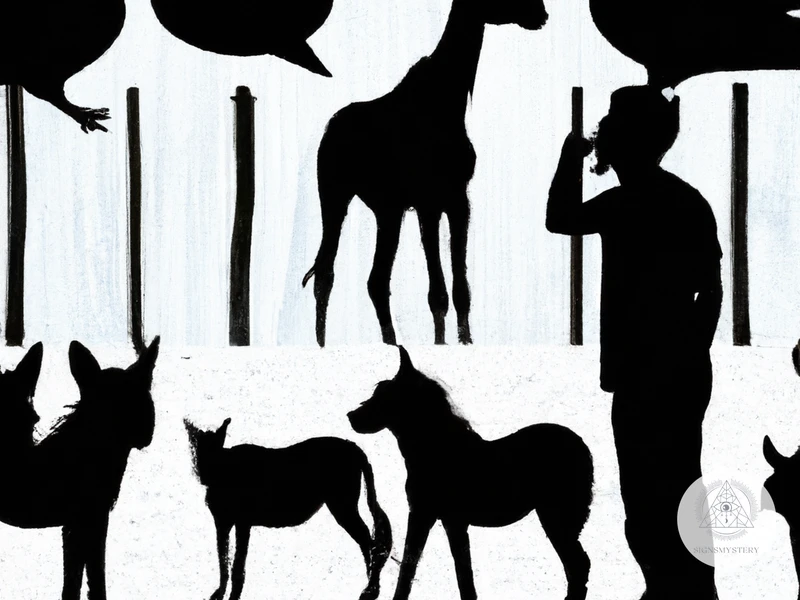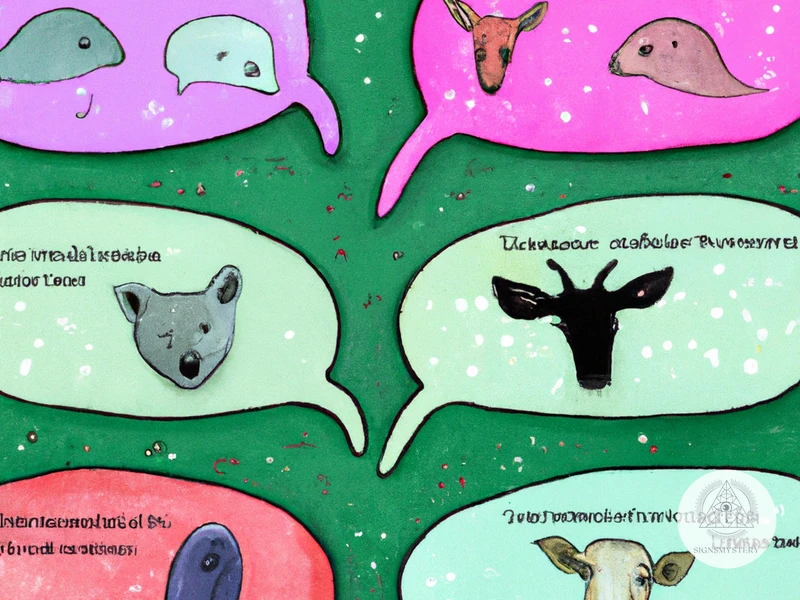Have you ever wondered how animals communicate with each other? There are many misconceptions surrounding animal communication that often lead to misunderstandings. In this article, we will debunk some of the most common misconceptions and shed light on the truth behind animal communication. From the belief that animals understand human language to the assumption that animal communication is only about telepathy, we will explore the fascinating world of animal communication and the different forms it can take. Join us on this journey as we unravel the mysteries and misconceptions surrounding animal communication.
Misconception 1: Animals Understand Human Language

Contrary to popular belief, animals do not understand human language in the same way that we do. While some animals may be able to pick up on certain words or commands through training, their comprehension is primarily based on associative learning rather than understanding the actual meaning of the words. For example, a dog may learn to associate the word “sit” with the action of sitting down, but they do not understand the word itself as a concept.
Additionally, the vocalizations and communication systems used by animals vary greatly from human language. Animals have their own ways of communicating with each other, such as through body language, vocalizations, scent marking, and even through electrical signals in the case of certain fish. Trying to communicate with animals using human language can lead to misunderstandings and frustration.
While animals may not understand human language, they have their own complex systems of communication that are adapted to their species-specific needs. For example, birds use intricate songs to communicate with each other, conveying messages about territory, mating status, and warning signals. Bees perform intricate dances to communicate the location of food sources to their hive mates. Dolphins communicate through a series of clicks, whistles, and body movements.
To truly understand animal communication, it is important to study and observe their natural behaviors and signals. By learning to recognize and interpret the various cues and signals that animals use, we can gain a deeper understanding of their needs, emotions, and intentions. It is through this understanding that we can establish a stronger connection and foster better relationships with the animals around us.
1.1 The Truth Behind It
The truth behind the misconception that animals understand human language lies in the fundamental differences between human and animal communication. While humans primarily rely on spoken and written language to convey meaning, animals communicate through a combination of vocalizations, body language, scent, and other sensory cues.
Animals have their own intricate systems of communication that are specific to their species. For example, primates use a combination of vocalizations, facial expressions, and body movements to communicate with each other. They may also use gestures and touch to convey social messages and establish hierarchies within their groups.
Some animals, such as dogs, have been domesticated and trained to respond to human commands and cues. While dogs can learn to associate certain words or gestures with specific actions, it doesn’t mean they understand the words themselves. They are simply responding to the familiar patterns and cues that have been reinforced through training.
It’s important to recognize that animal communication is complex and multifaceted. Each species has its own unique ways of conveying information and interacting with their environment and other members of their species. Understanding and appreciating these diverse communication systems is key to developing a deeper connection and respect for the animals we share our lives with.
1.2 Understanding Animal Communication
Understanding animal communication is a fascinating field that involves studying the various ways in which animals transmit and receive information. While animals may not understand human language, they have intricate systems of communication that are specific to their species.
[Anchor: Animal communication methods]Animals communicate through a combination of vocalizations, body language, scent marking, and even electrical signals. For example, wolves use howling to communicate with other pack members over long distances, while subtle changes in a cat’s tail position can convey important messages about its mood or intentions. Elephants communicate through low-frequency rumbles that can travel for miles, allowing them to coordinate movements and warn of potential threats.
[Anchor: Animal empathy]Understanding animal communication also involves recognizing the importance of empathy and emotional intelligence. Animals, like humans, experience a wide range of emotions and have complex social structures. By observing their behavior and body language, we can gain insights into their emotional states and needs. This knowledge can help us better care for their well-being and develop stronger bonds with them.
[Anchor: Animal telepathy]While animals may not possess telepathic abilities in the supernatural sense, they can still communicate non-verbally and pick up on subtle cues. For example, dogs can sense their owners’ emotions and respond accordingly, often providing comfort and support in times of distress. This heightened sensitivity to human emotions is believed to be a result of the strong bond that has developed between humans and dogs over thousands of years of coexistence.
Understanding animal communication requires us to step outside of our own human-centric perspective and appreciate the richness and complexity of the communication systems that animals have evolved. By recognizing and respecting their unique ways of communicating, we can deepen our connection with the animal kingdom and foster greater understanding and compassion.
Misconception 2: Animal Communication Is Only About Telepathy
One common misconception about animal communication is that it is solely based on telepathy. While telepathy, the ability to communicate thoughts and feelings without the use of verbal or physical cues, is often associated with animal communication, it is not the only form of communication that animals rely on. In fact, telepathic communication between humans and animals is not scientifically proven or widely accepted.
Animal communication encompasses a wide range of modes beyond telepathy. Animals communicate through a combination of visual cues, vocalizations, body language, and scent signals, depending on their species and natural behaviors. For example, wolves use a complex system of vocalizations, including howls, growls, and barks, to convey different messages related to warning, calling for assistance, or social bonding. Similarly, visual displays such as the vibrant feather displays of birds or the tail-wagging of dogs can communicate emotional states or intentions.
Additionally, animals communicate through chemical signals or pheromones, which can relay information about mating availability, territorial boundaries, or even danger. For example, ants use pheromones to create trails, guiding other members of their colony to food sources.
While the concept of telepathic animal communication may be enticing, it is important to recognize and appreciate the diverse range of communication methods used by animals in their natural habitats. By understanding and respecting these various forms of communication, we can better connect with and appreciate the animals around us.
2.1 The Misunderstanding
The misconception surrounding animal communication is often centered around the belief that it is solely based on telepathy, the ability to transmit thoughts or feelings without the use of conventional communication methods. While telepathy is a fascinating concept, it is not the only form of animal communication, and attributing all animal communication to telepathy is a misunderstanding.
Animal communication encompasses a wide range of methods that animals use to convey information to one another. These methods can include vocalizations, body language, visual signals, chemical signals, and even electrical signals. Each species has its own unique set of communication tools that have evolved to serve specific purposes and functions within their social structures and environments.
Telepathy, as commonly understood, refers to the direct mind-to-mind communication between individuals without the need for any external cues or signals. While there is ongoing research and speculation about the existence of telepathic abilities in certain species, such claims require rigorous scientific investigation before they can be accepted as valid.
It is important to approach the topic of animal communication with curiosity and an open mind, while also acknowledging the importance of critical thinking and scientific evidence. By embracing the diverse forms of communication used by animals, we can gain a deeper appreciation for their intricate and fascinating ways of interacting with the world around them.
2.2 Different Forms of Animal Communication
Animal communication takes many different forms, each adapted to the unique needs and abilities of different species. Here are some of the diverse ways in which animals communicate:
- Vocalizations: Many animals, such as birds, mammals, and amphibians, use vocalizations to communicate. These can range from simple calls and cries to complex songs and melodies. For example, the melodious songs of birds are used for attracting mates and defending territories.
- Body Language: Animals often use body language to convey messages and emotions. This can include gestures, postures, and movements. For instance, a dog wagging its tail can indicate happiness or excitement, while a raised paw can be a sign of submission or a request for attention.
- Chemical Communication: Many animals use chemical signals, such as pheromones, to communicate with others. Pheromones can convey information about reproduction, territory marking, identification, and more. For instance, ants use chemical trails to guide other members of their colony to food sources.
- Visual Displays: Some animals have elaborate visual displays that they use to communicate. This can include vibrant colors, patterns, or unique physical features. For example, peacocks display their magnificent feathers as a form of courtship display to attract mates.
- Electrical Signals: Certain species of fish, such as electric eels and electric rays, use electrical signals to communicate and navigate their environment. These electrical signals can be used for locating prey, detecting obstacles, and even for communication between individuals.
- Dances and Movements: Some animals communicate through rhythmic movements and dances. For example, bees perform complex dances to communicate the location of food sources to other members of their colony.
These are just a few examples of the diverse ways in which animals communicate. Each species has its own unique set of communication tools and signals that have evolved to serve specific purposes in their natural environments. By understanding and appreciating these different forms of animal communication, we can gain insight into the fascinating world of animal behavior and enhance our interactions with the animal kingdom.
Misconception 3: Animal Communicators Can Read Minds

Contrary to popular belief, animal communicators do not possess the ability to read minds. Instead, they use their intuition and observational skills to interpret the behaviors, body language, and energetic signals of animals. Animal communicators focus on creating a connection with the animal and tuning in to their emotions and needs. They may use techniques such as meditation, visualization, and energy work to enhance their ability to communicate with animals.
Animal communicators rely heavily on observing an animal’s behavioral cues and body language to understand their communication. They pay close attention to how an animal moves, the position of their ears, tail, and body, as well as any vocalizations or facial expressions. These subtle cues provide valuable information about an animal’s state of mind, emotions, and intentions. By attuning themselves to these signals, animal communicators can develop a deeper understanding of an animal’s needs and desires.
Animal communicators also take into consideration the environmental factors affecting an animal’s behavior, such as their habitat, social dynamics, and past experiences. By considering the holistic picture, including both the animal’s internal and external world, animal communicators can provide insights into the animal’s well-being and help foster better understanding and communication between humans and animals.
3.1 What Animal Communicators Really Do
What Animal Communicators Really Do
Animal communicators play a unique role in bridging the gap between humans and animals, but it’s important to dispel the misconception that they have the ability to read minds. Animal communicators are individuals who have honed their skills in understanding and interpreting animal behavior, body language, and vocalizations. They use their intuition and empathic abilities to establish a connection with animals and communicate with them on a deeper level.
Animal communicators often work by tuning into an animal’s energy and emotions, allowing them to gain insights into what the animal may be experiencing or trying to communicate. Through this process, animal communicators can ask the animal questions and receive responses through their intuition or through subtle cues and reactions from the animal.
It’s important to note that animal communication is not a one-way conversation where the animal communicator simply relays messages from the animal. Instead, it is a collaborative process where the animal communicator and the animal work together to establish a mutual understanding.
Animal communicators can assist in various situations, such as helping to address behavioral issues, providing emotional support to animals in distress, or even facilitating communication between pets and their owners. However, it’s essential to approach animal communication with an open mind and understand its limitations.
While animal communicators can provide valuable insights and assistance, they are not a replacement for proper veterinary care or training. Animal communication should be seen as a complementary tool in understanding and deepening the bond between humans and animals, rather than a magical solution.
If you’re interested in exploring the spiritual aspect of animal communication or the role of spirit animals in shamanic journeying, you may find this article helpful in expanding your knowledge.
3.2 Interpreting Behavioral Cues and Body Language
When it comes to animal communication, one of the key aspects is the ability to interpret behavioral cues and body language. Animals rely heavily on nonverbal signals to express their emotions, intentions, and needs. By paying close attention to these cues, we can gain valuable insights into their communication.
Behavioral cues include a wide range of actions and movements that animals use to convey their messages. For example, a dog wagging its tail usually signifies happiness or excitement, while a tucked tail may indicate fear or submission. Cats communicate through various body postures, such as arched backs when they are feeling threatened or relaxed when they are content.
Additionally, animals use body language to establish boundaries, communicate dominance, or express social hierarchy. For instance, a dominant wolf may hold its head up high and assertively stare at another wolf to establish its dominance. On the other hand, a submissive wolf may crouch down, tuck its tail, and avert its gaze to show submission.
Interpreting these behavioral cues and body language requires careful observation and understanding of the specific species. It is important to note that different animals may have unique ways of expressing themselves. For example, horse communication relies heavily on body language, with subtle movements such as ear positioning, tail swishing, and hoof stomping indicating their emotions or intentions. By familiarizing ourselves with these cues, we can deepen our understanding of animals and improve our ability to communicate with them.
By paying attention to behavioral cues and body language, we can bridge the communication gap between humans and animals. Understanding and respecting these nonverbal signals allows us to forge stronger connections and build trust with the animal kingdom. So the next time you interact with an animal, take a moment to observe their behavior and body language – you may be surprised by the depth of their communication.
Misconception 4: All Animals Communicate the Same Way
One common misconception is that all animals communicate in the same way. However, the reality is that animal communication is incredibly diverse and varies greatly across different species. Each species has developed its own unique communication system that is adapted to their specific needs and environments.
For example, mammals often rely on vocalizations, body language, and scent marking to communicate with each other. Dogs use a combination of barks, growls, wagging tails, and various body postures to convey their intentions and emotions. On the other hand, whales and dolphins communicate through a complex system of clicks, whistles, and body movements, which allows them to communicate underwater over long distances.
Other animals, such as birds, have their own specialized communication methods. Birds use a combination of vocalizations, such as songs and calls, as well as visual displays such as colorful plumage or elaborate courtship dances. These signals are used to attract mates, defend territories, and warn of potential threats.
There are also animals that have developed unique communication systems that are unlike anything humans typically encounter. For instance, bees communicate through a complex dance language. When a bee finds a valuable food source, it returns to the hive and performs a dance that provides precise information about the location, distance, and quality of the food source. By decoding the bee’s dance, other bees in the hive are able to navigate to the food source successfully.
Another fascinating example of unique animal communication is seen in fireflies. Fireflies communicate with each other through flashes of light, using specific patterns and timings to convey messages for mating or territorial purposes. Each species of firefly has its own distinct flash pattern, allowing them to recognize their own kind and find suitable mates in a sea of blinking lights.
These examples demonstrate the incredible diversity and adaptability of animal communication systems. They highlight the fact that different species have evolved their own sophisticated methods of communication, which are perfectly suited to their specific needs and environments.
4.1 The Diverse World of Animal Communication
Animal communication is a diverse and fascinating field, with each species having its own unique ways of conveying messages and information. While some forms of communication may be similar across multiple species, there are also significant differences that highlight the diversity of animal communication methods.
One common form of animal communication is through vocalizations. Different species produce a wide array of sounds, ranging from simple chirps and barks to complex songs and melodic calls. Birds, for example, use their songs to establish territory, attract mates, and communicate alarm signals. Whales and dolphins communicate through a series of clicks, whistles, and songs, which can be heard over long distances underwater.
Visual communication is another important aspect of animal communication. Many animals use their body language, facial expressions, and gestures to convey messages to others. For instance, wolves use body postures and facial expressions to establish dominance, show submission, or express aggression. Bees perform intricate dance movements to communicate the location of food sources to their hive mates.
Scent marking is yet another form of animal communication, particularly prominent among mammals. Animals such as cats, dogs, and many other carnivores use their urine, feces, or scent glands to leave marks that convey information about their presence, territory, and reproductive status. These marks can be detected and deciphered by other members of their species, providing valuable information about potential mates or rivals.
Animal totems and spirit animals are also deeply rooted in various cultures around the world, where specific animals are believed to hold symbolic meanings and
Subscribe to Our Newsletter
Sign up to receive the latest news and updates.
The diverse world of animal communication showcases the remarkable adaptability and complexity of communication systems developed by different species. Each communication method serves a specific purpose within the social dynamics and survival strategies of the animals. By studying and understanding these diverse communication systems, we can gain a deeper appreciation for the richness and intricacies of the animal kingdom.
4.2 Examples of Unique Animal Communication Systems
- Honeybees: Honeybees have a fascinating communication system known as the waggle dance. When a foraging honeybee returns to the hive, it performs a series of intricate movements and vibrations to convey information about the location of a food source. The angle and duration of the dance communicate the direction and distance of the food source from the hive, allowing other bees to navigate and find the food.
- Elephants: Elephants have a wide range of vocalizations, including trumpet calls, rumbles, and low-frequency infrasound. These vocalizations are used for various purposes, such as expressing emotions, coordinating group movements, and warning others of potential dangers. Elephants can also communicate through seismic signals, using their sensitive feet to pick up vibrations in the ground.
- Fireflies: Fireflies use a unique form of communication called bioluminescence. They produce light through a chemical reaction in their bodies, creating flashes of light that are used to attract mates. Each species of firefly has its own distinct flash pattern and timing, allowing them to identify potential mates of the same species.
- Whales: Whales are known for their complex songs, which are thought to play a role in communication and mate attraction. Male whales produce intricate and melodic songs that can last for hours. These songs can travel long distances through the water and are believed to carry messages about their identity, location, and reproductive fitness.
These are just a few examples of the diverse and unique communication systems found in the animal kingdom. Each species has its own specialized ways of communicating, perfectly suited to their environment and social structure. By studying and understanding these communication systems, we can gain a deeper appreciation for the complexity and richness of animal communication.
Misconception 5: Anyone Can Communicate with Animals

It is a common misconception that anyone can communicate with animals. While it is true that animal communication is a natural ability that humans possess, it is not something that can be easily developed by everyone. Animal communication is a skill that requires practice, patience, and a deep level of sensitivity towards animals.
Developing the skill of animal communication involves honing our intuitive abilities and learning to listen and observe animals in a different way. It is about attuning ourselves to their energy, emotions, and subtle cues. It is not simply a matter of talking to animals and expecting them to respond in human language.
Experience plays a crucial role in animal communication. The more we interact with animals, the more we learn about their unique behaviors, communication styles, and individual personalities. Each animal is different, and it takes time to develop a deep understanding and connection with them.
Sensitivity is also a vital aspect of animal communication. Animals are highly perceptive beings, and they can sense our intentions, emotions, and energy. If we approach them with fear, unease, or any negative emotions, it can hinder the communication process. Developing a calm, open, and compassionate demeanor is key to establishing a harmonious connection with animals.
While anyone can learn the basics of animal communication, becoming skilled at it requires dedication and a genuine love for animals. It is a journey of continuous learning and growth, deepening our bond with the animal kingdom. So, while the ability to communicate with animals is within us all, it takes time, effort, and a genuine passion for animals to truly become proficient in this art.
5.1 Developing the Skill of Animal Communication
Developing the skill of animal communication requires patience, practice, and an open mind. While some people may have a natural affinity for connecting with animals, it is a skill that can be developed and honed over time. Here are some steps you can take to enhance your ability to communicate with animals:
- Deepen your connection: Building a strong bond with animals is essential for effective communication. Spend time observing and connecting with animals in their natural environment. This can help you develop a deeper understanding of their behavior and communication cues.
- Learn their language: Each species has its own unique way of communicating. Educate yourself about the specific communication methods used by the animals you wish to communicate with. For example, if you’re interested in communicating with horses, learn about their body language, vocalizations, and behavioral patterns. This will help you better understand their messages and respond appropriately.
- Practice active listening: Animal communication is a two-way process. Practice active listening by quieting your mind and being fully present when connecting with animals. Pay attention to their body language, vocalizations, and any other cues they may be giving. This will help you establish a deeper connection and understand their needs and desires.
- Develop your intuition: Trusting your intuition is a crucial aspect of animal communication. As you practice and connect with animals, pay attention to any intuitive insights or feelings that arise. These subtle cues can provide valuable information and enhance your communication skills.
- Seek guidance: If you’re serious about developing your animal communication skills, consider seeking guidance from experienced animal communicators or attending workshops and courses. Learning from those who have honed their skills can provide valuable insights and techniques to enhance your own abilities.
Remember, developing the skill of animal communication takes time and dedication. Approach it with an open mind, respect for the animals, and a willingness to learn. With practice and experience, you can deepen your connection with animals and further explore the fascinating world of animal communication.
5.2 The Importance of Experience and Sensitivity
When it comes to animal communication, experience and sensitivity play crucial roles in honing this skill. While anyone can develop the ability to communicate with animals, it takes practice, patience, and a deep understanding of their behavior and non-verbal cues.
Experience is important because it allows animal communicators to become familiar with the different communication styles and patterns exhibited by various species. By working with a wide range of animals and encountering different situations, communicators can gather invaluable insights into the diverse ways animals communicate. This knowledge helps them to better understand and interpret the messages animals are trying to convey.
Sensitivity is equally significant as it enables communicators to attune themselves to the subtleties of animal communication. This involves being able to pick up on slight changes in body language, vocalizations, and energy levels. A highly sensitive communicator can perceive the emotions, intentions, and needs of an animal, even when they are not explicitly expressed.
Developing experience and sensitivity in animal communication is an ongoing journey that requires dedication and openness. It involves actively listening to animals, observing their behaviors, and continuously refining one’s intuitive abilities. By doing so, communicators can deepen their connection with animals and create a harmonious and empathetic relationship based on mutual understanding.
Conclusion
Animal communication is a complex and fascinating topic that is often misunderstood. In this article, we have debunked some of the most common misconceptions surrounding animal communication. We have learned that animals do not understand human language in the same way that we do, and that their communication systems are unique to their species. While animal communication may involve forms of telepathy, it is not limited to that alone. Animal communicators do not read minds but rather interpret behavioral cues and body language to understand animals better.
Furthermore, we have explored the diverse world of animal communication, where different species have evolved their own unique ways of sharing information and conveying messages. It is important to acknowledge that not all animals communicate in the same way, and understanding their specific communication systems and signals is crucial for effective communication.
Lastly, we have highlighted that while anyone can develop the skill of animal communication, it requires experience, sensitivity, and a deep understanding of the species being communicated with. It is a skill that can be honed through practice and patience.
By dispelling these misconceptions and gaining a deeper understanding of animal communication, we can foster better relationships with animals and enrich our interactions with the natural world. So, let us embrace the diversity of animal communication and continue to explore and learn from the fascinating ways in which animals communicate.
For more information on the cultural significance of horse spirit animals, you can read our article on the history and symbolism of horse spirit animals.
Frequently Asked Questions

FAQ 1: Can animals learn to understand human language?
No, animals do not understand human language in the same way that we do. While they may be able to associate certain words or commands with specific actions through training, their comprehension is based on associative learning rather than understanding the meaning of the words themselves.
FAQ 2: How do animals communicate with each other?
Animals communicate with each other through a variety of methods including body language, vocalizations, scent marking, and even electrical signals in some cases. Each species has its own unique ways of conveying messages and establishing communication within their social groups.
FAQ 3: Can animals understand our emotions?
While animals may be sensitive to human emotions, they do not necessarily understand them in the same way that we do. They can pick up on our body language, tone of voice, and energy to gauge our emotions and react accordingly.
FAQ 4: Is telepathy a real form of animal communication?
Telepathy, the ability to communicate thoughts or ideas through extrasensory means, is not a scientifically proven form of animal communication. Animals primarily rely on their natural communication systems rather than telepathic communication.
FAQ 5: Can anyone learn to communicate with animals?
While anyone can learn about animal communication and its various methods, developing a deep understanding and connection with animals requires practice, experience, and sensitivity. It is not a skill that can be learned overnight.
FAQ 6: Are there different languages among animals?
Yes, animals have their own unique forms of communication, which can vary greatly between species. For example, dolphins use clicks, whistles, and body movements, while bees communicate through intricate dances and birds use intricate songs.
FAQ 7: Can animal communicators read the minds of animals?
No, animal communicators cannot read the minds of animals. They rely on their observation skills, intuition, and the ability to interpret the behavioral cues and body language of animals to understand their needs and intentions.
FAQ 8: How can I better understand my pet’s communication?
To better understand your pet’s communication, it is important to observe their behavior, body language, and vocalizations. Pay attention to their cues and signals, and spend quality time bonding with them to develop a stronger connection.
FAQ 9: Can animals communicate across different species?
While animals may not be able to communicate with each other in the same way that humans communicate, there are instances where different species can interact and understand each other to a certain extent. For example, some bird species have alarm calls that warn other animals of potential threats.
FAQ 10: How can I improve my animal communication skills?
To enhance your animal communication skills, it is important to practice active listening, observe animals in their natural environments, and seek guidance from experienced animal communicators or trainers who can provide valuable insights and techniques.
References
Frequently Asked Questions

FAQ 1: Can animals really communicate with humans?
Yes, animals can communicate with humans, but their methods of communication may be different than what we are accustomed to. Understanding their communication cues and signals is key in establishing a connection with them.
FAQ 2: Is animal communication limited to telepathy?
No, animal communication encompasses various forms such as vocalizations, body language, and scent marking. While some intuitives may claim telepathy, it is just one aspect of animal communication and not the sole means of communication.
FAQ 3: Can animal communicators read the minds of animals?
No, animal communicators cannot read the minds of animals. They rely on observation, intuition, and their ability to interpret behavioral cues and body language to understand the messages animals convey.
FAQ 4: Do all animals communicate in the same way?
No, animals have diverse communication systems. Different species have evolved unique ways of communicating with each other, which can include vocalizations, visual displays, or even chemical signals.
FAQ 5: Can anyone learn to communicate with animals?
While anyone can develop an understanding of animal communication, honing the skill requires practice, patience, and sensitivity. It takes time to learn to interpret the subtle cues and messages animals send.
FAQ 6: How do animals understand human language?
Animals may not understand human language in the same way we do, but they can learn to associate certain words or tones of voice with specific actions or emotions. Additionally, they rely heavily on non-verbal cues to gauge our intentions.
FAQ 7: Are there any specific training or courses to become an animal communicator?
There are various training programs and courses available for those interested in becoming animal communicators. These courses help individuals develop their intuition and understanding of animal behavior to improve their communication skills.
FAQ 8: Can animal communication help in resolving behavioral issues?
Yes, animal communication can be a useful tool in understanding the underlying causes of behavioral issues in animals. By communicating with the animal, an intuitive can gain insights into their emotions, past traumas, or any other factors contributing to the behavior.
FAQ 9: Is animal communication a scientifically proven phenomenon?
Animal communication is a widely observed and documented phenomenon, but the field is still evolving, and there is ongoing research to understand the intricacies of animal communication better.
FAQ 10: How can animal communication benefit pet owners?
Animal communication can deepen the bond between pet owners and their animals, improve understanding, and address any concerns or issues the animal may have. It allows for a more holistic approach to their care and well-being.










